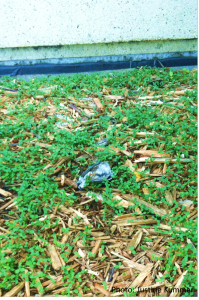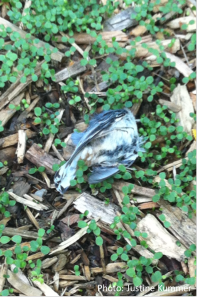Searching For Window Collision Evidence Protocol
As part of the University of Alberta’s Birds and Windows Project, we are looking for people to search for evidence of bird window collisions on a regular basis. Ideally you will search your residence daily for a period of at least one month. There is no limit to the number of months you can be involved in the project however, if a daily search does not suit your lifestyle we still want you to participate. We simply need you to keep track of which days you searched for evidence of a collision. To effectively monitor bird window collisions we need to know when people find evidence of a collision BUT it is equally important that we also know when no evidence is found.
We prefer daily searches as previous studies have shown this reduces the chance of evidence being lost due to searcher error or evidence being removed by scavengers. If window collision evidence is observed at a time other than during a perimeter search try to complete a full search at this time to maintain consistency and account for the possibility of multiple collisions.
Evidence of bird window strikes include dead or injured birds found beneath a window or blood smears, body smudges or feathers found on the window glass (see descriptions and images below). To help in understanding what happened to the bird when it collided, please take a photo of the collision evidence to be uploaded to the survey. Photos will help provide accurate species identification. If a dead bird and a body smudge on the glass are found for the same collision, take a picture of the bird as it will be used to identify the species.
The perimeter search should include a 2 meter radius of the entire building. Searchers should look for birds on the ground, in and around the vegetation and on balconies and sidewalks. As well, all windows should be checked for collision evidence. Be sure to thoroughly check all vegetation around windows within the 2 meter radius. Birds are drawn to these trees and shrubs for food and habitat and in doing so are more likely to be involved in a window collision.
If you live in an apartment please search your balcony and conduct your collision evidence walk around the entire building. In an apartment it is expected you only check your windows for collision evidence and not all the windows in the building. If your home is attached to at least one other dwelling (row housing, duplexes, semi-detached and single-attached homes) please only search the perimeter and exterior walls of your home. Detached garages should also be searched for collision evidence.
To reduce the chance of missing evidence, use a pace of one step per second. Additionally, after searching the building once, reverse your direction and walk around a second time. When looking for evidence on windows do not search while walking, be sure to stop and then look at the window to reduce the possibility of evidence on the ground being missed.
After completing the perimeter search enter results in the online calendar. Information can be entered by clicking the plus sign on each date. It is crucial that you enter results even on days when no collision evidence was found. If collision evidence is found, there will be two series of questions to answer regarding specific characteristics of the collision.
What do I do with the window killed birds I find?
You can give them to the Ornithology department at the Royal Alberta Museum so they can be prepared as a study skin, mount or skeleton and used for education and research purposes. Click on this link for more information: http://www.royalalbertamuseum.ca/research/lifeSciences/ornithology/faq.cfm
Please contact us if you have any questions (birdsandwindows@ualberta.ca).
Window Collision Evidence
A dead bird – a dead bird is found within 2m of the buildings edge, be sure to thoroughly check all nearby trees and shrubbery
An injured bird – an injured bird is found within 2m of a buildings edge, be sure to thoroughly check all nearby trees and shrubbery
A bird feather stuck to the window – A feather was found stuck to the window following the collision.
A blood smear on the window – A smear of blood is found on the window where the collision occurred.
A body smudge or dust imprint on the window – Birds create a dust that comes from little pieces of their feathers when they preen or flap their wings. Leftover dust, accompanied by a large body smudge may be found on a window following a collision.


A sound of a bird striking a window – often a loud ‘thunk’ noise, like a tennis ball hitting a window. Be sure to check the window and outside for additional evidence.
I saw the bird collide with a window – You witnessed the bird colliding with the window. Be sure to check the window and outside for additional evidence.


